Adventurer Conqueror King System by ZeeToo
| 1 | Introduction |
| 2 | Characters |
| 3 | Equipment |
| 4 | Proficiencies |
| 5 | Adventuring |
| 6 | Magic Research |
| 7 | Monsters |
| 8 | Treasure |
| 9 | Wrap-Up |
Introduction
Original SA post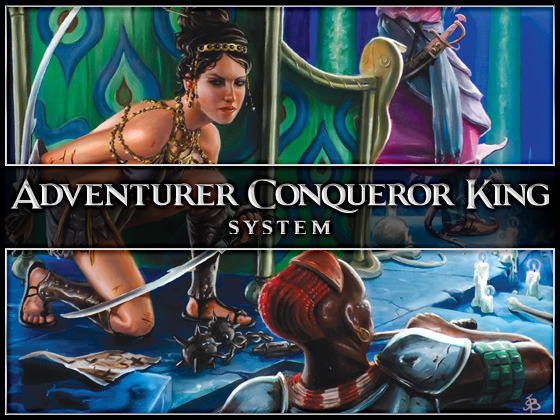
Adventurer Conqueror King System , part 1
With thanks to VacuumJockey, I'm going to look at ACKS (pronounced AXE according to the book
 ).
).
I have a confession to make: I'm essentially a d20 boy. I played some AD&D with my father, while too young to really understand and follow much beyond rote play. That's my sole experience with any D&D older than 3.0. So the clearly old-school ACKS? It's not an obvious match to make.
However, skimming it once has given me a very positive first impression! Let's see if I can communicate the what and the why, and if that holds true as I look more closely.
The PDF VJ supplied is peppered with internal links; if something says to turn to chapter 6, clicking on it takes me to chapter six--this even extends to spells and other little things. Nice. The book is laid out very sensibly and clearly, and has some clear and evocative black-and-white art that stays in a very consistent style. The visuals aren't as good as Exalted or D&D, but they're very good and contribute well to its good overall impression.
The book's foreword opens with a neat background story of the world, intermixed with a functional account of what the game is about. Chapter 1, the introduction, lays out the necessary how-tos and basic terminology very well. From rolling xdy+z to game specifics like a domain, it's here and clear. The only real surprise is the chapter ending with a suggestion on what to roll for "Judge (GM) decides", where it lays out the utility and variance of rolling 1d6, 2d6, or 1d20 to figure out what happens based on how random or skewed you want the result to be.
That's just the very basics, of course. The next chapter is about creating characters--I'll look at that next time.
Characters
Original SA post
Adventurer Conqueror King System , part 2
So this is slightly belated, but anyway. ACKS. Last time, I'd given my general(ly positive) impressions of the overall system. Today, we start looking at characters. Not hitting everything, just what looks notable.
We apparently start as a 0th level human. Some classes are locked by race. Until I come across something stating differently, I thus assume that 0th level humans level up into 1st level elves or dwarves sometimes.
To create a character, roll 3d6 6 times, in order, then select a class it fits. This is the first time the record skips for me. I like having a lot more control over what my character is like, but ACKS is determinedly and intentionally old school. It gives an optional rule to roll 5 characters at once, and pick your favorites. I'll accept that.
Hit points... roll at 1st level, or at the DM/GM/"Judge" 's discretion, just assume max.
Classes have a Prime Requisite , in addition to ability score minimums for the non-human classes. If your Prime Requisite is 13-15, you get +5% experience. 16+, +10%. So if you're better at your class at a given level, you level up faster, too. Classes also level up at different rates, with the necessary amounts on their class charts. Not fond of this, personally.
Anyway, once you have a class, you can lower non-Prime Requisites by 2 to raise your Prime Requisite by 1. So you basically just roll for if you can be a dwarf and overall strength of non-main-abilities.
 Okaaaay. That's a pretty backwards way to do it, to me, but isn't an unfeasible way of customizing your stat spread.
Okaaaay. That's a pretty backwards way to do it, to me, but isn't an unfeasible way of customizing your stat spread.
Classes!
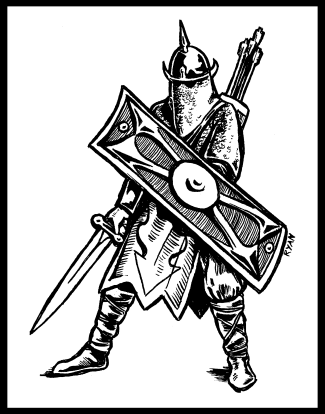
I love this art.
The Fighter advances in his attack throws and saving throws by 2 every 3 levels and the whole phraseology seems incredibly goofy to my 3rd-and-later self. It's clear enough, honestly. Just weird. I have no issue actually using it, though.
A fighter also gets damage bonuses with weapons, inspires troops, and can eventually choose to build a castle and attract automatic followers. Actually, everyone can eventually get followers of some stripe and amount; I won't bring that out in the others.
The Mage increases his attacks and saving throws by two every six levels, instead of one every three levels, because ACKS likes to phrase things in bizarre ways. (Actually it's for uniformity; by having all the classes increase by "two per x levels", it doesn't require even trivial math to compare 'em. You can just look. But don't spoil my mathy indignation.)
Mages get spells up to level 6 normally. 7th to 9th level spells? Those are apparently special rituals, not normal magic. When you start to have access to them, you also get to be able to create magical crossbreeds and create constructs. I haven't read that far yet, but I'm interested to see what they've got.
A Cleric doesn't get divine spells until level 2, but is comparable to the fighter at first level so that's okay. He can also turn undead at will, which is an instant kill on such baddies, but if he ever flubs it it's out for the rest of the encounter. Clerics have rituals like mages, but of only 6th and 7th level.
ACKS Thief has only 1d4 HP, but an array of other things to call on. He has a big ol' chart for thief-y skills to use, and can backstab for big damage bonuses if the enemy is unaware of them. It's all straightforward in use and not fiddly like 3.x loose skill points are. At higher levels they can read almost anything and eventually cast arcane magic from scrolls.
These four are the normal classes. They have one prime requisite, and no required scores. There's also four "campaign classes" which have two prime requisites (you take the lower for your experience boost), but no requirements.
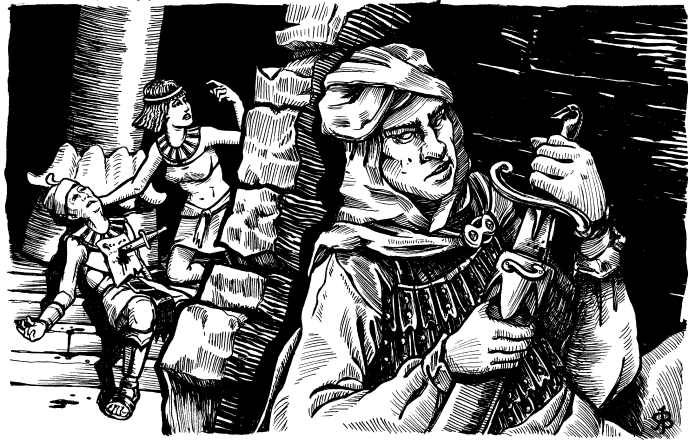
Assassin is the first, and basically a combination fighter and thief. He can fight like a fighter, save for lower HP, and can sneak and backstab like a thief, though he loses out on the other skills. He actually levels up faster than the fighter, too.
The Bard is fairly familiar to what I learned in 3rd edition D&D. Medium fighter, can inspire courage, has the equivalent of bardic knowledge (more or less), and use arcane magic items. Also the bard picture in the book is great:
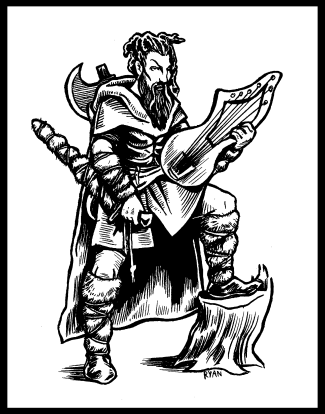
Next, the Bladedancer is the cleric, except instead of swinging bashing weapons around in heavy armor he dual-wields sharp things and sticks to light armor.
Finally, the Explorer is the ranger: fights like a fighter, with special bonuses to ranged weapons, and is a good guide in the great outdoors.
The last thing in the chapter is the "Demi-human classes". Two dwarven classes mandate at least 9 con, and two elf classes round out the chapter. They uniquely don't advance all the way to ACKS' normal max level of 14 like all the others do.
The Dwarven Vaultguard is a fighter with amazing saving throws and what's familiar to me as stonecunning.
Companion to that is the Dwarven Craftpriest , which is a cleric with some extra crafting bonuses and stonecunning. However, he caps out first of all the classes: his last level is 10, and he reaches that at less than half the experience total that a mage does, for instance.
If dwarves aren't to your speed, there's the Elven Spellsword , who fight like a fighter and cast spells, even while armored up to the gills. Oh, oh, and they're attuned to nature! And have keen eyes! And they're immune to paralysis! And they look absolutely fabulous in any outfits, and are all rock stars! Okay, I'm lying about that last sentence. Their only apparent weakness is a very slow experience progression.
If you don't want to get blood on your cloak, there's also the Elven Nightblade , which is effectively the thief/mage class. They only get spells up to level 3, which is rather anemic in comparison, but their backstabs are much better than the thief's, thanks to their unique trick of tumbling past opponents to actually stab them in the back.
The chapter ends with a short bit on alignments and adventuring parties. Basically, be Law/Neutral/Chaos, with Neutral probably easiest, and it might be neat to hire people to trail along behind you, to sum it up.
Next time: equipment. And hirelings are apparently a sort of semi-free-range equipment.
Equipment
Original SA post
Adventurer Conqueror King System , part 3
We're on to equipment!
Every ACKS character starts with a free set of sturdy clothes and 3d6x10 gp. Coins, including electrum pieces, are given exchange rates on a chart. You can equip and use any weapons or armor you want, but if you equip armor or grab a weapon you don't know how to use, you can't use class features or earn XP and you fight like a 0th level character. Apparently if you glue a sword into a dwarven craftpriest's hands, he loses the ACKS version of stonecunning and stops being a dwarf (0th level characters are humans).
Novel.
Okay, if you want to purchase warhorses in bulk for your army, there's a set of rules for availability. Little places just run out of available transactions that month.
There's charts of all the expected stuff. Basic adventuring gear, armor... whuh? Is that ascending AC I spot? Huh. Okay. Weapon lists, clothing, livestock...
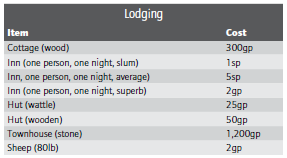
...Lodging? An 80-lb sheep is lodging now?
"Hey, Bob the Basher, where do you wanna settle down? I've been thinking of a wooden cottage, or a stone townhouse if I can afford it, but a wattle hut is probably more homey for you, huh?"
"I will live in a sheep, Migby."
Anyway, Encumbrance is next up. Fairly sane. "Items" are just abstractly given a generic weight, but the amount you can carry without penalty is really low and doesn't scale with strength or anything.
Get hirelings and/or pack animals. They're next up; a sort of free-range semi-self-directed equipment. There's rules about recruiting, how many can be recruited where... it looks quite workable, but not much review-worthy.
Hirelings have a few basic rules about how much they need to be paid, how loyal they feel, how they'll be really hesitant working for someone who's less powerful than they are...
The rest of the chapter is descriptions of various hireling types. You can get a healer, a healer - physicker, or a healer - chirugeon, for instance.
Engineers are needed; a minimum of one engineer is needed per large building project, one for every 100,000 gp of its cost or fraction thereof. Animal trainers let you ride hippogriffs or train carnivorous apes as guard animals (those are the listed examples
 ). Sages let you get DM knowledge of various topics (a sage of [topic], essentially), with a note saying that they can be wrong. Spellcasters are rare, especially high-level spellcasters, and charge by the spell, it looks, so you can wander into even a pretty large city and come up with one guy who can regrow limbs and none who can cure lycanthropy, or whatever collection of terrible ailments your party has managed to pick up on their adventures.
). Sages let you get DM knowledge of various topics (a sage of [topic], essentially), with a note saying that they can be wrong. Spellcasters are rare, especially high-level spellcasters, and charge by the spell, it looks, so you can wander into even a pretty large city and come up with one guy who can regrow limbs and none who can cure lycanthropy, or whatever collection of terrible ailments your party has managed to pick up on their adventures.
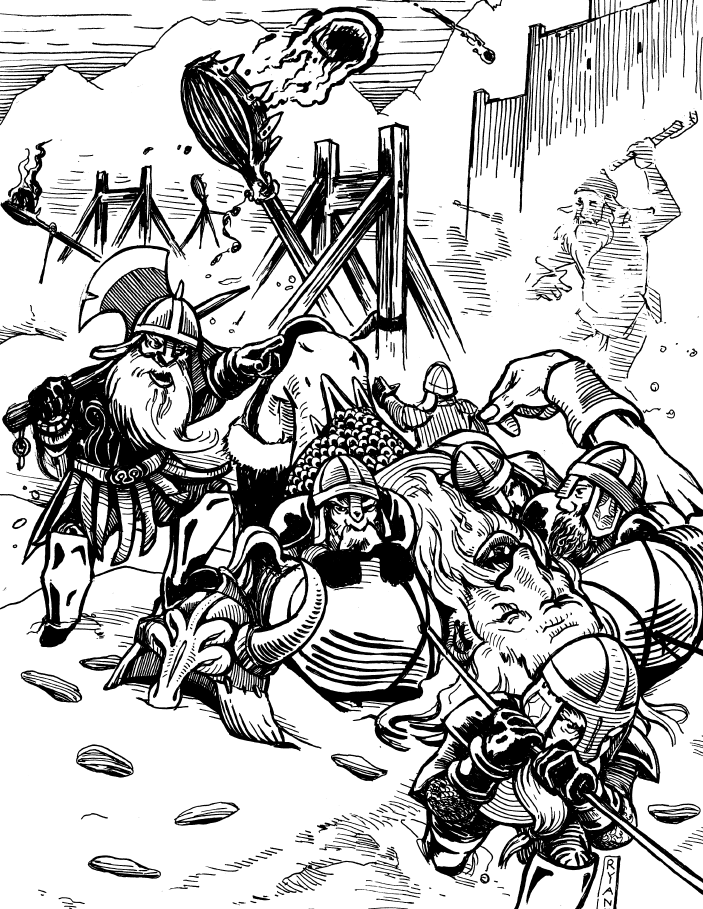
I haven't mentioned this update that I love the art yet; I'm not sharing most of the full-page pictures I come across.
Next time: Proficiencies!
Proficiencies
Original SA post
Adventurer Conqueror King System , part 4
Proficiencies are your customization beyond ability scores and equipment. You get "Adventuring" for free, one general proficiency, and one class-based proficiency.
Also another proficiency per point of int bonus, because only smart people can be both adept at manual labor and have good endurance.
Seems fair.
There's a chart to tell us what level you get what additional proficiences and a class-based list of what proficiences you get, all of which is straightforward and sensible, so let's just see if there's something novel in the proficiencies themselves.
Acrobatics gives you some expected bonuses to moving, comes free for elven nightblades, and is so useful to thieves that unless they don't fight at all they probably want this.
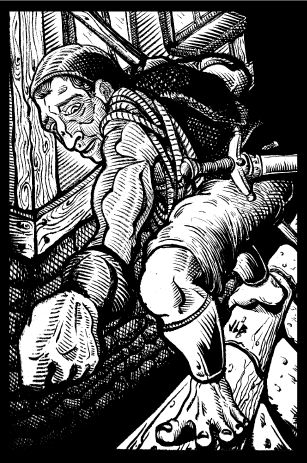
Adventuring is one every character gets free and says that you aren't a complete bumbling incompetent, so the GM shouldn't screw you over because your character sheet doesn't say Will Not Unquestioningly Give All Money To Suspicious Strangers or something.
Arcane Dabbling lets you operate wands and staves like you're a mage.
Black Lore of Zahar is a necromantic bent to your elf or mage.
Elven Bloodline means a character's lifespan is three times normal and he is immune to paralysis. Sadly, elves cannot take it.
Healing can be selected up to three times, making you a much better doctor each time. or you can learn to Lay on Hands and be a faith healer who's, you know, actually more effective than a doctor instead of less. To be fair, Healing inclues poison and disease care, not just HP restoration and Lay on Hands is more limited by class.
Prophecy is also available to those clerics who like to read the last two chapters of mysteries first. Soothsaying is the mage version.
Theology lets you know about religion and gives you a place in a church hierarchy. And isn't limited to just clerics, because I guess class isn't entirely identity.

Unflappable Casting lets a mage whose spell is interrupted turn around and stab a dude instead of crying about it for the rest of his turn.
That's kinda short, so let's hit up the next chapter: Spells!

 +
+

Anyway, on the first page of the capter, ACKS says it's having nothing to do with this "Vancian" nonsense, and if you know a spell and have the slots left to cast it you can. Great!
There's some odd insistence on telling us how spells interact with next chapter's initiative rules, and thus makes me wonder why that didn't go first. Oh, well.
Divine spell lists are provided by your god and can be themed to match, at the GM's discretion. Arcane spellcasters tend not to keep a lot of spells active, because, if I'm reading this right, he has to keep up a lifestyle consistent with the spell, which can involve appeasing ghosts, observing various taboos, and all of this can vary by your location and the phases of the moon and isn't given any annoying actual weight in play. So you can learn a wide variety of spells, but only have certain sets prepared, and you can cast all of what you have prepared and are living out
There's even advice about what spells are good first choices, so you don't have to play hunt-the-system-mastery when your first level mage has a class feature of Can Do One Spell.
Mages all have 'spell signatures', which means that the visual effects are flavored to match the character's overall theme, so a necromancer's magic missile launches shards of bone and his wall of stone resembles tombstones.
ACKS magic is cooler than any edition of D&D.
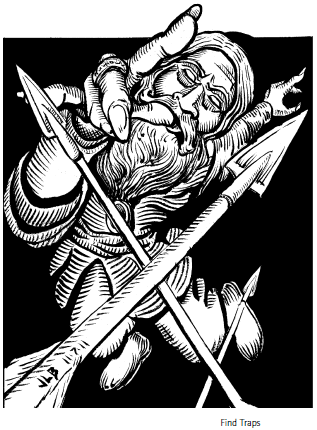
Okay, mostly
The actual spell list is... pretty much exactly what you'd expect. Fireball is 3rd level arcane, and does 1d6 points of damage per caster level. Web is 2nd level arcane, tying up people who aren't very strong in flammable webs. Haste ages the target. You know the general idea.
Next time: adventures!
Adventuring
Original SA post
Adventurer Conqueror King System , part 5
Adventuring! This
Of note is that ACKS has different time scales for exploring and combat and such, and is actually good enough to give 'em different terminology.
Light, dark, listening at doors and making noise, traps... hey, apparently traps only trigger a third of the time that you stumble into them? Odd. We don't get details on any traps here, save for the pit trap. Maybe that comes later.
Wilderness exploration has general movement rates, getting lost, how much and how fast you have to eat, how to forage for food (which apparently always also includes a random encounter, assumedly in addition to what you actually eat... although some of the monsters may also be edible), how fast you move by air...
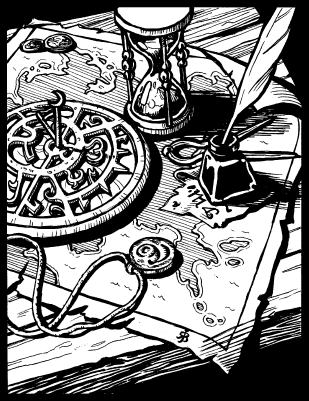
Although I suppose air travel could also do over the sea, sea movement gets its own sections. Ships get a table, from canoes up to war galleons. Rules for tacking, rowing... eh. Honestly, I've never much enjoyed sea based adventures. I find it hard to get worked up about this bit.
Then, encounters! Yeah, we got the general exploration rules for every terrain type, and now we get the fighting, instead of it being grouped by area. Not how I would have done it, but still sensible enough. In wilderness exploration, we roll to see how far away we start. Depending on terrain and roll, it could start at five yards or a thousand. Does seem like it really strongly promotes carrying around something to give you some ranged power, at least.
Actually filling out your wandering monster chart is a job for another chapter, though, it seems.
Surprise! Only now do we get to surprise! And sneaking. And then monster reactions (2d6+your lead's CHA), which we're told can be interpreted by context. If they get an indifferent reaction to you, but successfully evade your notice, they might just leave. Whew! I was afraid we might have something happen.
There's also rules for running away, which have a little more mechanical weight than everyone moving 30 ft forever until someone gets bored, thankfully. You can always run away if the other side is surprised.
Assuming both sides are aware of each other, and not indifferent or helpful, and no one tries to run away, and terrain allows, and whatever other excuses are worked through, then we're forced to fight. So now... it's time for initiative!
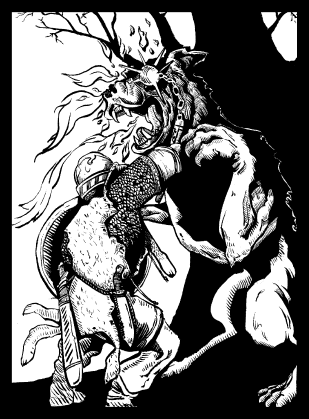
If you're waving around a polearm, you can actually hit someone who's trying to close with you, and thus share his initiative instead of using your own, if it's lower. That's... really neat. There's a good reason to be using them!
We've sort of seamlessly worked into our combat rules here. Combat movement, with charging and fighting withdrawal and whatnot, are given. It's very familiar to my 3rd edition eyes, though I don't know if that's because 3rd didn't change older stuff or if ACKS just saw it and took it. There's a few changes, though, like charging has a lot more reach here.
I'm skipping the basic rules of attacking, though I will say that I'm very fond of ACKS dual wielding. Instead of doubling your attacks, you get a +1 to attack (plus its enhancement bonuses) for the second weapon. Damn, I like this.
To cast a spell, you have to declare it before you roll the round's initiative, and you lose it if you take damage or fail a saving throw. Since initiative is rolled every round and d6+Dex mod, this isn't unfeasible on either using or negating it.
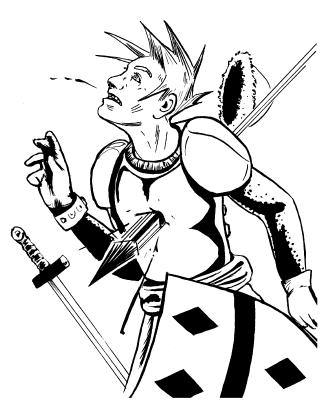
Damage works like you'd expect. The first novel bit is that you don't roll for how hurt you are for going under 0 HP until you get treated for it. There's a chart, of course. Depending on everything, you can get results ranging from fleeting visions of the afterlife to "Not even the vultures could feed on you". Restoring life is similar, but its chart is a little nastier. If you're very lucky you come back with a prophecy or some vital power, but you can also end up beholden to do a quest, blinded, with reduced CON and WIS or... "Your soul is extinguished in the oblivion of nothingness". Yeah, revival isn't reliable.
A neat thing about ACKS is that it gives everyone some basic competency that costs so many feats in d20. Dropping your bow to draw a sword? Sure, free action. Dropped a foe? Cleave rules let you hit the next guy in line, no character investment needed to do it. It's nice to just see a game give you the stuff you need to be a badass adventurers instead of having superlative mages and a giant shopping list of feats for fighters.
Special maneuvers come next. We know these. It's the same sunder/disarm/overrun/etc that we all know already. Looks more feasible than 3.5's versions, though, generally speaking.
Monsters (though explicitly never PCs, yay) have morale. If they start to see their allies get slaughtered, they eventually tend to lose their nerve and break and run.
The rest of the chapter is full of the fiddly bits you need to know if you need it, and don't care about otherwise, like ship hit points, swimming while fighting, etc. None of it is particularly inspiring.
Next time : Campaigns! We'll be looking at a bunch of things important for persistent play.
Magic Research
Original SA post
Adventurer Conqueror King System , part 6
We open the section on campaigns with a quick blurb on what it is ('making your mark on the world'), before diving straight into magic research.
Again ACKS just sticks basic competency in the character without forcing you to officially pick it. 5th level or higher casters can research spells, scribe scolls, and brew potions. As he gains more levels, he gradually gains access to making magical weapons and so on, eventually getting to make golems and go lich-y if he's chaotic.
Honestly, that bit irks me enough for a brief rant. I know it's D&D standard, but when making the world's greatest sword, why is the magic-user the authority? Why isn't the best smith in the world the important part of the process? or the most skilled swordsman? That's rhetorical; I just dislike the answer.
Naturally, spell research is also how you identify the properties of an unknown magic item. Give the magic sword to the mage, don't let the peerless swordsman identify it.
Anyway, there's some write-up on costs and timing and rolls which are of more interest to a player than a reviewer. Money is the big cost, and XP is never a part of it like 3.x D&D. It'll also chew up a lot of time. Even a single healing potion takes a week. You don't just whomp up Exalibur Senior in a weekend.
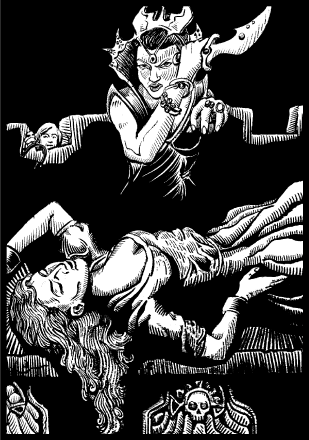
This is right next to the rules on assistants.
It's a hazardous profession. I guess.
The list of ritual spells is next. These are the epic spells, the important ones that take time and preperation to even cast. There's a total of five. One apiece per spell level, of divine and arcane. Kind of anemic.
There's a few pages on the details of making magical golems, magically crossbreeding creatures, and working necromancy.
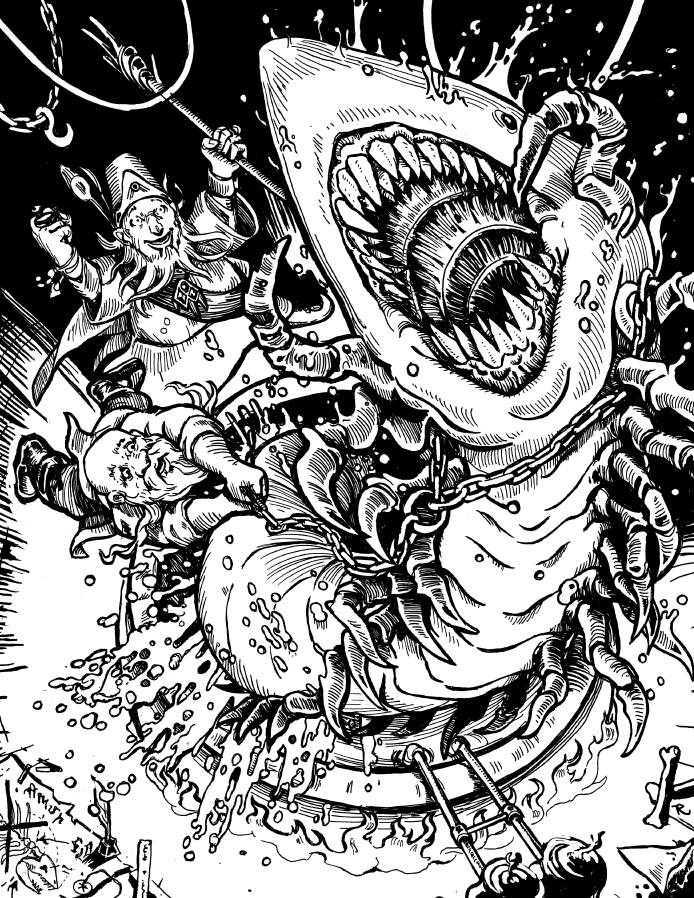
I don't recall the details, but I'm sure they're awesome.
Divine spellcasters can tap into the size of their congregation to substitute faith for money. Chaotic ones have another option open: blood sacrifices for power. It hs to be either an unwilling or non-chaotic creature for it to do something beyond get your robes messy, though.
For those with more political ambitions or who just aren't spellworkers, there's domains. Grab a chunk of land and administrate it, collecting tax as you do so. This is where ACKS ends up in chart-based hell. I count no less than 19 charts dealing with establishing and managing your land. These range from what sort of troops you get through the titles you can earn to the effects of seasonal events. I'm not much interested in this style of play, personally.
For Chaotic people, again, things get more interesting. Instead of just humans and demi-humans, you instead cow the local beastmen tribes and get a pliable chieftan under your rule. Near as I can follow, you get faster growth in exchange for a permanent diplomatic incident and less tax revenue.
You can also make a Dwarf
Elves, of course, get almost exactly the same thing. Their unique thing is that animals spy for them.
If you're a thief-y sort, instead of this sort of general land administration, you can form a criminal guild and keep your little syndicate busy assassinating, smuggling, stealing, and carousing(?). This segues smoothly into getting caught while doing such perfidy and the justice system you'll have to beat if you do. Punishments range from being fined 1 gp up through agonizing death or getting sentenced to something worse, like being crossbred into that rad sharkipede a little further up.
Magic users get their own special options: sanctums and dungeons. Sanctums are magic colleges, attracting low-level magic users and non-mage hopefuls. Of rather more interest are dungeons. Rather than go hunting for 20 hellhounds when they need them for a spell, mages apparently dig dungeons and seed them with treasure to convince hellhounds to move in ahead of time. More amazingly, this works.
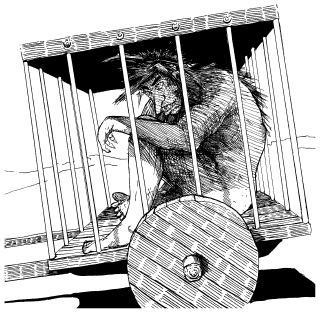
If you're unlucky, you don't get monsters: you attract adventurers instead. ACKS suggests the rather amusing possibility of the dungeon-owner mage playing a one-off with other players trying to raid his dungeon as the wandering adventurers as he tries to stop them.
That's about where the chapter's interesting things end, but it goes on for another half-dozen pages on playing merchant and the experience for all of this.
Now that we know how to sell them stuff, next time we'll take a look at the monsters of the ACKS world.
Monsters
Original SA postWell, I'm coming in as a d20 boy, and I see the appeal. It's a little fiddly in a couple of ways that I don't entirely care for, but ACKS, at least, is a good game which is deliberately aping a playstyle. It's almost that simple, and you aren't entirely running a meatgrinder.
Well, mostly not, maybe. That segues into:

Adventurer Conqueror King System , part 6
We're into the monsters! ACKS uses 'monster' for all the stuff you try to stab and/or fireball to death. Dragon? Monster. Town guard? Monster. Catfish? Monster (why are you fighting a catfish?)
The game gives a pretty good summary of what its stats mean so the DM can get into it if he's unfamiliar, including what it means to be 'in its lair' or not, and going over special attacks. Almost all of these are horrifying effects that can and will severely screw with you, from poison (save or just die) to energy drain (you lose a level and go down to starting XP for that total, can only be undone with Wish ).
The monster list is pretty good. There's a nice spread of monsters, they don't waste time on enemies which most PCs won't fight--there's no angels or other foes which you presumably aren't likely to need to stab on sight. Actually, there's no demons, either; ACKS is most definitely 'grounded' in its world and you aren't expected to go gallivating off to Sigil or get on a spelljammer ship.

Not all the monsters have art, and most of those which do stick to this silhouette style.
From lycanthropic demon boars to elves, from centipedes to gelatinous cubes, there's a lot here, most of which has a paragraph on how to make it work for you.
Some notable monsters include the hydra, where regrowing heads actually doesn't come standard (though it can be added), the skittering maw (that sharkipede I showed before), swarms (mechanically sensible, with a neat note that if you run away you keep taking damage for a bit because you can't get all the swarm off you that quickly), and the wight (extremely low-level undead with energy drain)

Also, crawling skeletons
Only three monsters pass 5,000 xp, and all of them actually are above 12,000. These are the cataclysmic threats, the monsters which could define the campaign. These are the dragon, the roc, and
Dragons, of course, merit special mention. They have age categories and hit most of the familiar D&D colors and powers, though mixed up enough to not fall afoul of copyright. They have breath weapons, scary natural attacks, and a grab bag of special powers. If it can speak (a % chance by age), it can cast arcane spells, and may be able to polymorph into a humanoid. Other options in the grab bag include poisonous blood, an aura of fear or some elemental energy, and a vorpal bite. Don't fuck with dragons, basically.
...Although their treasure is tempting.
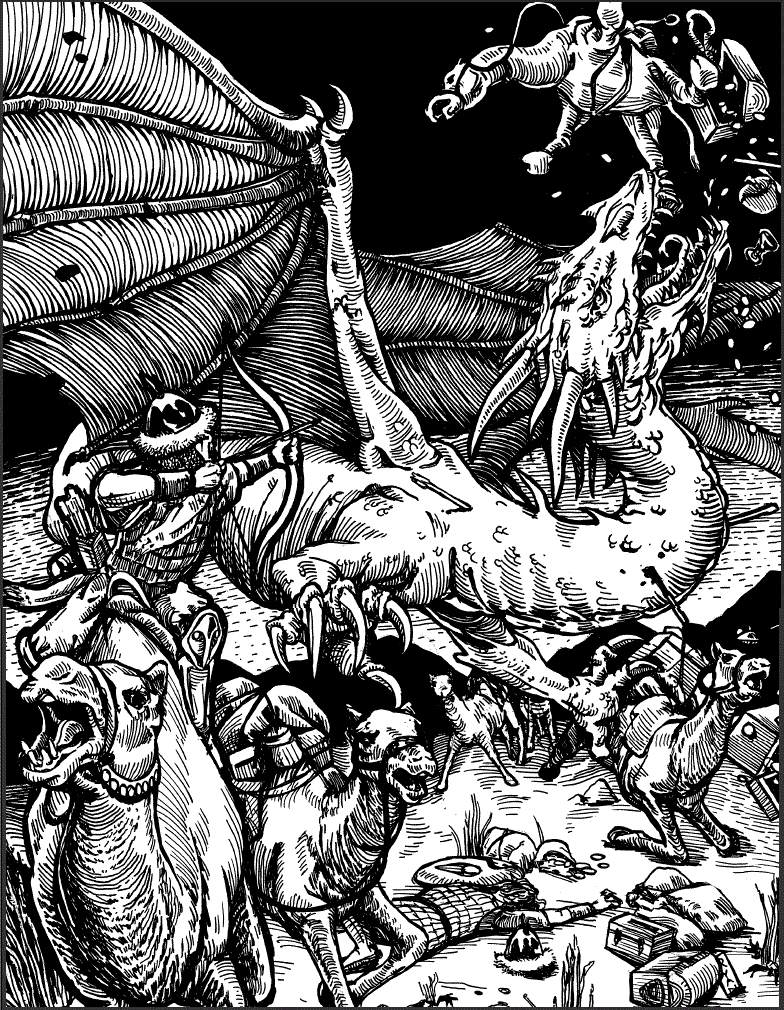
If we don't die, we'll look at the treasure next time
Treasure
Original SA post
Adventurer Conqueror King System , part 7
If we're risking our life and oh-so-fragile characters to govern domains and fight off monsters, you gotta expect to get paid. Oh, and treasure correlates to XP, to the point of being the primary expected source. So this is kind of an important element. Magic items are very important, but don't qualify for XP. Apparently, experience radiation only comes from precious metals.
The game goes over keeping the right ratio of monster experience to treasure and how to generate it; it's pretty clear but hardly riveting to a third party. Luckily, we pretty quickly get to interesting stuff. Instead of just piles of coins and/or gems, there's lots of suggestions for special treasures of equivalent values. Fur coats, rare books or spices, fine liquor... it even lists engraved teeth here.
To prevent the low-level moneygrubber from going around collecting kobold knives and tin helmets, there's charts on how much damage something has taken and its resulting loss of utility and resale value.
Now, onto the meat: magic items. There's some unusually awkward explanation covering how to identify magic items, then the charts to roll 'em up, and finally the list of examples.
Notable ones include:
-
Potion of Delusion
: You think it's another potion, and 90% chance multiple people trying it all get the same bad result. Also comes in all other treasure types...
or does it?

-
Oil of Sharpness
: Rub it on anything sharp to make it a +1 sword, or increase its magic by a +1. If you drink it instead, it makes you fart.
-
Cursed Scroll
: Read scroll, magic item disappears, or you might end up at level 1 and unable to earn experience.
- Rod of Resurrection : Did you know it's 50% harder to resurrect a fighter than a cleric? And an elf takes more charges than both combined? Now you do!
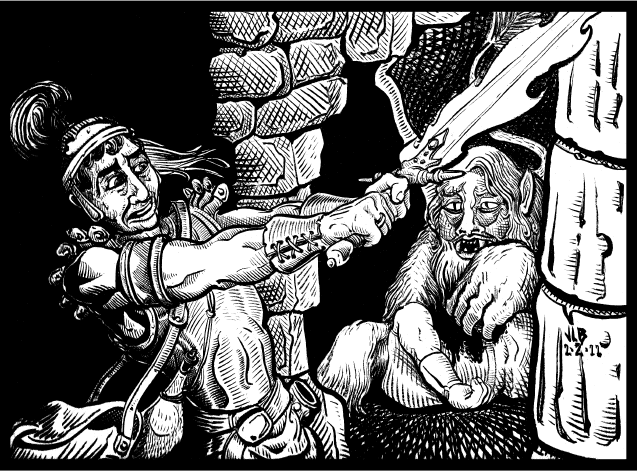
Weapons only go up to +3 under normal circumstances, and +1 (+2/+3 vs Specific Thing) seems to dominate the non-generic weapon lists.
There's also intelligent weapons, which seems eeriely similar to the D&D 3.x experience I'm familiar with. They only have a 5% chance of having a specific motivation at all, though, which gets me thinking of intelligent weapons striving to control their owners just so they can laze around in bed all day.
Next time:
The end!

Wrap-Up
Original SA post
Adventurer Conqueror King System , part 8
The last section in ACKS is "secrets". Near as I can tell, this is a grab bag of extra GMing tools that didn't fit elsewhere. We start with graphing the campaign setting, one 24-mile hex and one 6-mile hex at a time, depending on detail needed. There's charts on how a given size of national holding corresponds to ACKS' rules on domains.
Then it gets into the sort of detail that I find boring and uninteresting, though I honestly can't say 'irrelevant' when ACKS specfically goes into why it's important in this game. Population density, urban demographics, demand modifiers to represent trade routes, a straight-up full page chart on environmental modifiers to demand for various goods, and NPC level distribution by realm chart. Eh.
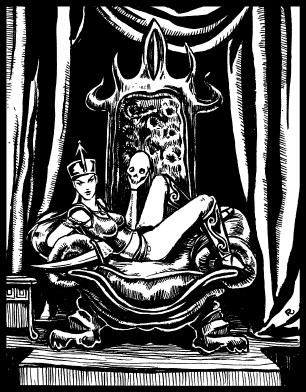
Now we get into pre-placing lairs. This is basically "fill the map with encounters before the PCs come around". This is where you make the world feel a bit lived in. The example has some sheep and gazelle around to be preyed on by manticores that are the main encounter.
To avoid either designing things to be always level-specific to the PCs or having The Lair Of Very Fast People Eaters right next to where you start, ACKS suggests having a 'borderlands' for the PCs: the further you go from civilization, the generally harder encounters get. I can get behind that. If the mere existence of encounters isn't enough to get your murder-hobo band started, there's some discussion of other hooks.
Finally, though, we get into designing the dungeons that are kind of important to the genre. Trap rules are repeated (essentially, 1/3 the time you might trigger it, it happens) and we finally get a list of traps. There's a bit on making 'unique encounters' that give dungeons a little more feel to them, another on wandering monsters to make monsters less than purely reactive and stuff on arranging treasure dispensation. Dungeon encounter tables give way to wilderness encounter tables and then to NPC adventuring party encounter tables.
Then, aging, poison use, and slavery.
 I guess they all gotta go somewhere, but the progression isn't exactly intuitive.
I guess they all gotta go somewhere, but the progression isn't exactly intuitive.
Sinkholes of evil! Here we go. The nebulous powers of Nether Darkness create regions of foul chaotic magic, causing a variety of nasty effects. An industrious party can stem this corruption and clean up the area.
If you really must there's even rules on starting above 1st level instead of properly questing for every XP you gain. You filthy cheater. This is actually where the name comes from, though. Adventurers, Conqueror, or King are the given amount of XP you're given to start.
That's, essentially, the end of things. The book ends with 15 pages of useful charts and summaries and a nice index, to make it easy to find things.
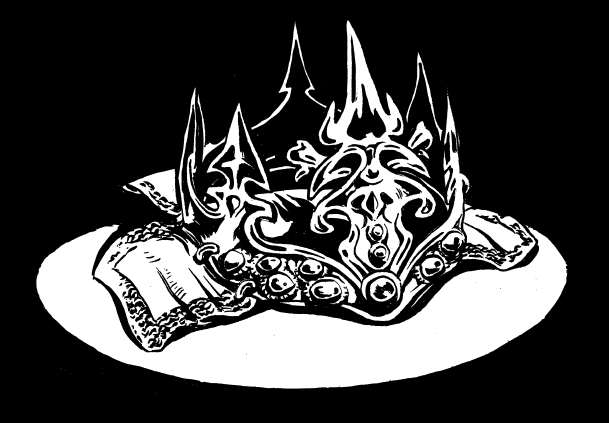
So, overall? I think ACKS is a really cool game system, and I have to thank VacuumJockey for sharing it with me. Hex crawls aren't my favorite style of gameplay, but ACKS lays out how to make it at least interesting. I likely wouldn't run it, but only because of the 'what style I prefer to run' routine. The overall "slightly Middle Eastern" feel to the art helps, though; it makes ACKS look a lot different and memorable than the scads of pseudo-Medieval Europe games out there. I would be pretty happy playing ACKS with friends. If you're either considering a hex/dungeon crawl game or just don't understand the appeal but would like to see what the fuss is about, give it a look.
Finally, I really have to end with praising the care put in again again. This book is extremely well cross-referenced, and the PDF makes them all into simple internal links for even faster finding. The art is well-chosen and evocative, and the whole thing is laid out well and clearly. There are a couple of hiccups, and I've mentioned them when I found them, but a great deal of craftsmanship went into this game, and it shows.